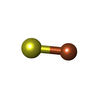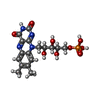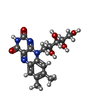[English] 日本語
 Yorodumi
Yorodumi- EMDB-14622: Na+ - translocating ferredoxin: NAD+ reductase (Rnf) of C. tetano... -
+ Open data
Open data
- Basic information
Basic information
| Entry |  | |||||||||
|---|---|---|---|---|---|---|---|---|---|---|
| Title | Na+ - translocating ferredoxin: NAD+ reductase (Rnf) of C. tetanomorphum | |||||||||
 Map data Map data | ||||||||||
 Sample Sample |
| |||||||||
 Keywords Keywords | Rnf / flavin / iron-sulfur cluster / sodium ion translocation / anaerobic energy metabolism / oxidoreductase / electron transport / redox-coupled sodium pump / FLAVOPROTEIN | |||||||||
| Biological species |  Clostridium tetanomorphum (bacteria) Clostridium tetanomorphum (bacteria) | |||||||||
| Method | single particle reconstruction / cryo EM / Resolution: 4.27 Å | |||||||||
 Authors Authors | Ermler U / Vitt S / Buckel W | |||||||||
| Funding support |  Germany, 1 items Germany, 1 items
| |||||||||
 Citation Citation |  Journal: Nat Commun / Year: 2022 Journal: Nat Commun / Year: 2022Title: Purification and structural characterization of the Na-translocating ferredoxin: NAD reductase (Rnf) complex of Clostridium tetanomorphum. Authors: Stella Vitt / Simone Prinz / Martin Eisinger / Ulrich Ermler / Wolfgang Buckel /  Abstract: Various microbial metabolisms use H/Na-translocating ferredoxin:NAD reductase (Rnf) either to exergonically oxidize reduced ferredoxin by NAD for generating a transmembrane electrochemical potential ...Various microbial metabolisms use H/Na-translocating ferredoxin:NAD reductase (Rnf) either to exergonically oxidize reduced ferredoxin by NAD for generating a transmembrane electrochemical potential or reversely to exploit the latter for producing reduced ferredoxin. For cryo-EM structural analysis, we elaborated a quick four-step purification protocol for the Rnf complex from Clostridium tetanomorphum and integrated the homogeneous and active enzyme into a nanodisc. The obtained 4.27 Å density map largely allows chain tracing and redox cofactor identification complemented by biochemical data from entire Rnf and single subunits RnfB, RnfC and RnfG. On this basis, we postulated an electron transfer route between ferredoxin and NAD via eight [4Fe-4S] clusters, one Fe ion and four flavins crossing the cell membrane twice related to the pathway of NADH:ubiquinone reductase. Redox-coupled Na translocation is provided by orchestrating Na uptake/release, electrostatic effects of the assumed membrane-integrated FMN semiquinone anion and accompanied polypeptide rearrangements mediated by different redox steps. | |||||||||
| History |
|
- Structure visualization
Structure visualization
| Supplemental images |
|---|
- Downloads & links
Downloads & links
-EMDB archive
| Map data |  emd_14622.map.gz emd_14622.map.gz | 48.2 MB |  EMDB map data format EMDB map data format | |
|---|---|---|---|---|
| Header (meta data) |  emd-14622-v30.xml emd-14622-v30.xml emd-14622.xml emd-14622.xml | 21.1 KB 21.1 KB | Display Display |  EMDB header EMDB header |
| FSC (resolution estimation) |  emd_14622_fsc.xml emd_14622_fsc.xml | 8.6 KB | Display |  FSC data file FSC data file |
| Images |  emd_14622.png emd_14622.png | 45.6 KB | ||
| Masks |  emd_14622_msk_1.map emd_14622_msk_1.map | 52.7 MB |  Mask map Mask map | |
| Filedesc metadata |  emd-14622.cif.gz emd-14622.cif.gz | 6.8 KB | ||
| Others |  emd_14622_half_map_1.map.gz emd_14622_half_map_1.map.gz emd_14622_half_map_2.map.gz emd_14622_half_map_2.map.gz | 40.7 MB 40.7 MB | ||
| Archive directory |  http://ftp.pdbj.org/pub/emdb/structures/EMD-14622 http://ftp.pdbj.org/pub/emdb/structures/EMD-14622 ftp://ftp.pdbj.org/pub/emdb/structures/EMD-14622 ftp://ftp.pdbj.org/pub/emdb/structures/EMD-14622 | HTTPS FTP |
-Validation report
| Summary document |  emd_14622_validation.pdf.gz emd_14622_validation.pdf.gz | 951.9 KB | Display |  EMDB validaton report EMDB validaton report |
|---|---|---|---|---|
| Full document |  emd_14622_full_validation.pdf.gz emd_14622_full_validation.pdf.gz | 951.4 KB | Display | |
| Data in XML |  emd_14622_validation.xml.gz emd_14622_validation.xml.gz | 13.7 KB | Display | |
| Data in CIF |  emd_14622_validation.cif.gz emd_14622_validation.cif.gz | 18.9 KB | Display | |
| Arichive directory |  https://ftp.pdbj.org/pub/emdb/validation_reports/EMD-14622 https://ftp.pdbj.org/pub/emdb/validation_reports/EMD-14622 ftp://ftp.pdbj.org/pub/emdb/validation_reports/EMD-14622 ftp://ftp.pdbj.org/pub/emdb/validation_reports/EMD-14622 | HTTPS FTP |
-Related structure data
- Links
Links
| EMDB pages |  EMDB (EBI/PDBe) / EMDB (EBI/PDBe) /  EMDataResource EMDataResource |
|---|
- Map
Map
| File |  Download / File: emd_14622.map.gz / Format: CCP4 / Size: 52.7 MB / Type: IMAGE STORED AS FLOATING POINT NUMBER (4 BYTES) Download / File: emd_14622.map.gz / Format: CCP4 / Size: 52.7 MB / Type: IMAGE STORED AS FLOATING POINT NUMBER (4 BYTES) | ||||||||||||||||||||||||||||||||||||
|---|---|---|---|---|---|---|---|---|---|---|---|---|---|---|---|---|---|---|---|---|---|---|---|---|---|---|---|---|---|---|---|---|---|---|---|---|---|
| Projections & slices | Image control
Images are generated by Spider. | ||||||||||||||||||||||||||||||||||||
| Voxel size | X=Y=Z: 0.837 Å | ||||||||||||||||||||||||||||||||||||
| Density |
| ||||||||||||||||||||||||||||||||||||
| Symmetry | Space group: 1 | ||||||||||||||||||||||||||||||||||||
| Details | EMDB XML:
|
-Supplemental data
-Mask #1
| File |  emd_14622_msk_1.map emd_14622_msk_1.map | ||||||||||||
|---|---|---|---|---|---|---|---|---|---|---|---|---|---|
| Projections & Slices |
| ||||||||||||
| Density Histograms |
-Half map: #2
| File | emd_14622_half_map_1.map | ||||||||||||
|---|---|---|---|---|---|---|---|---|---|---|---|---|---|
| Projections & Slices |
| ||||||||||||
| Density Histograms |
-Half map: #1
| File | emd_14622_half_map_2.map | ||||||||||||
|---|---|---|---|---|---|---|---|---|---|---|---|---|---|
| Projections & Slices |
| ||||||||||||
| Density Histograms |
- Sample components
Sample components
+Entire : Na+ -translocating ferredoxin: NAD+ reductase (Rnf)
+Supramolecule #1: Na+ -translocating ferredoxin: NAD+ reductase (Rnf)
+Macromolecule #1: RnfA
+Macromolecule #2: RnfB
+Macromolecule #3: RnfC
+Macromolecule #4: RnfD
+Macromolecule #5: RnfE
+Macromolecule #6: RnfG
+Macromolecule #7: FE (III) ION
+Macromolecule #8: IRON/SULFUR CLUSTER
+Macromolecule #9: FLAVIN MONONUCLEOTIDE
+Macromolecule #10: RIBOFLAVIN
-Experimental details
-Structure determination
| Method | cryo EM |
|---|---|
 Processing Processing | single particle reconstruction |
| Aggregation state | particle |
- Sample preparation
Sample preparation
| Buffer | pH: 7.5 |
|---|---|
| Grid | Model: C-flat-2/1 / Material: COPPER / Mesh: 300 |
| Vitrification | Cryogen name: ETHANE |
- Electron microscopy
Electron microscopy
| Microscope | FEI TITAN KRIOS |
|---|---|
| Image recording | Film or detector model: GATAN K3 BIOQUANTUM (6k x 4k) / Average electron dose: 40.0 e/Å2 |
| Electron beam | Acceleration voltage: 300 kV / Electron source:  FIELD EMISSION GUN FIELD EMISSION GUN |
| Electron optics | Illumination mode: FLOOD BEAM / Imaging mode: BRIGHT FIELD / Cs: 2.7 mm / Nominal defocus max: 2.1 µm / Nominal defocus min: 1.2 µm / Nominal magnification: 105000 |
| Experimental equipment |  Model: Titan Krios / Image courtesy: FEI Company |
 Movie
Movie Controller
Controller




 Z (Sec.)
Z (Sec.) Y (Row.)
Y (Row.) X (Col.)
X (Col.)
















































